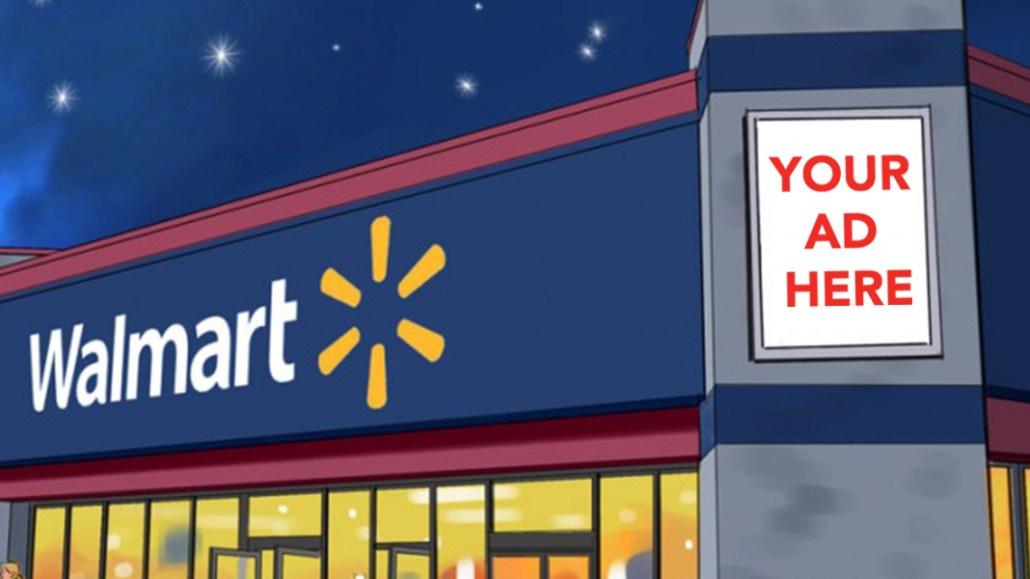With Amazon looming, Walmart quietly grows as an advertising force

With around 140 million people shopping at its 5,000 stores in the U.S. every week, Walmart is not just a retail giant. It is also a growing advertising platform that touts its ability to connect online consumer behavior and a mountain of in-store sales data that its biggest rival Amazon lacks.
Walmart wouldn’t provide executives to comment on this story, but conversations with agency executives revealed that Walmart is offering both insertion order-based media buys and programmatic display through Walmart Exchange, a media network the company introduced in 2014. Ad formats include banners, search ads, product listing ads and native ads in the “Sponsored Products” section on Walmart.com. Edward Yruma, managing director for investment bank KeyBanc, called Walmart’s advertising business an “underappreciated growth opportunity.” The company has been serving third-party display ads from other brands more often, rather than just promoting its own product offerings, according to Yruma.
“Ad load on Walmart.com is definitely increasing, and a growing number of our clients are interested to serve ads there,” said John Baker, CMO for agency Mirum. “Brands are interested in retail media because retailers know when people have intent to purchase something. That data is hugely valuable and enables advertisers to stand out from their competitors in e-commerce.”
Jason Goldberg, svp of commerce and content for agency SapientRazorfish, agreed, saying that back in 2014 when Walmart.com represented a small percentage of Walmart’s overall revenue, advertisers paid little attention to Walmart Exchange. But now, as Walmart’s e-commerce business grows and becomes a significant digital player, brands have realized Walmart.com is a lucrative ad vehicle.
Analysts and ad executives think that Walmart Exchange makes sense, as the retailer uses programmatic infrastructure combined with Walmart’s in-store sales data to target ads for brands and manufacturers. Similar to how Amazon buys ad inventory from other publishers, Walmart also buys ad inventory through Walmart Exchange from other demand-side platforms and publishers like YouTube and CBS Interactive and resells it to advertisers, according to agency executives. Those ad placements are cost-efficient and informed by Walmart’s first-party data, they said.
“In-store data is Walmart’s secret sauce,” said Susan Bidel, senior analyst for Forrester Research. “Amazon is Walmart’s biggest competitor, and it owns tremendous data. But Amazon lacks in-store data — the vast majority of commerce still takes place at brick-and-mortar stores today.”
Advertisers can use Walmart’s online and in-store data to exclude or include a specific audience group to come up with a target segment, said Thomas Stelter, vp of emerging solutions for creative agency Possible. For instance, a shoe brand that targets 25- to 40-year-old women with a household income of at least $50,000 a year can exclude people who bought shoes at Walmart over the past six months, so the brand won’t serve ads to this newly shoed group.
Stelter thinks that Walmart Exchange emulates Amazon, which processes data through Amazon’s advertising platform, a DSP owned by its in-house media shop Amazon Media Group, to drive online sales with targeted ads on sites across the web. (We asked Amazon for comment; we’ll update this story if we receive a response.)
He added that while the two retail giants are doing similar targeting, one advantage Amazon has over Walmart is its ability to capture shopping intent in a specific category. For instance, if a person is browsing pet toys and pet food on Amazon without making a purchase, Amazon still knows this person is interested in pet products. “I don’t think Walmart is there yet,” said Stelter.
Amazon is also getting more online search traffic than Walmart is, giving advertisers an incentive to be there so digital shoppers find their products, said Goldberg.
Walmart is not the only supermarket chain that capitalizes on in-store data to carve out a media business. Target, with 1,816 stores in the U.S., has an in-house data-management platform and a private marketplace for its supplier brands to serve targeted programmatic ads.
“Walmart Exchange is very similar to other large retailers getting into the ad business. It’s all about using personal information and purchase history to recognize and target customers on the web and email,” said Mani Gandham, CEO for marketing tech firm Instinctive. “It’s an easy way for [retailers] to make extra money from the data they already have, while helping their own attribution match rates.”
Goldberg thinks that whether Walmart or Amazon will win in the media space is less important because the real competition isn’t just between them — it’s between retailers and the likes of Google and Facebook.
“I think lots of manufacturers will shift their ad dollars from Google and Facebook to retail sites like Amazon and Walmart.com, as big retailers are getting more sophisticated about their online and in-store sales data,” he said.
More in Marketing

Pandora is betting on AI agents to scale service and emotional selling during the peak holiday season
Pandora is using AI agents to scale customer service and replicate emotional in-store selling online, just as peak season puts pressure on margins and teams.

Rembrand’s CEO wants to grow virtual ad placements in streaming, and he’s looking elsewhere for models
Omar Tawakol wants to improve advertising within the streaming world, and is working with advertisers and publishers to improve that experience.

Marketers are keen to use generative AI in ad campaigns, but hidden costs lurk
Marketers across the industry want to use AI to cut down on time spent in creative production. It’s not so simple in practice.








